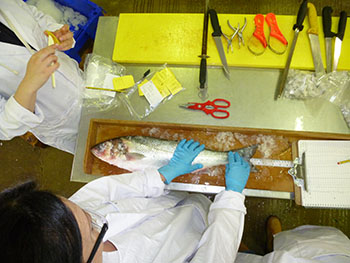Fishery
Fishery
D. labrax is the target species of both commercial and recreational fisheries.
Commercial fisheries
The official total bass landings in England and Wales from Sub-areas IV and VII rose from 106 t in 1985 to 680 t in 1999 and have averaged around 500 t since then. However most of the bass landed into the UK is taken by small inshore vessels in a mixed gear fishery and does not go through major ports: these figures are therefore underestimates. A combination of the official UK statistics and landings derived from a voluntary log-book scheme run by CEFAS produced best estimates, which suggest that landings remained around 600 t between 1985 and 1992, rising rapidly to 2200 t in 1994 (as the strong 1989 year class recruited), and then fluctuated between 1050 and 1900 t (mean approx. 1500 t) until 2005 (ICES, 2004; ICES, 2008). During this period, bass landings into England and Wales were mainly from netting and line métiers.
The main fishing gears used by the inshore UK fishing vessels are drift nets, gill nets, longline, angling, and rod and line. The mean value of catches estimated in 2002 for all nets was 16 kg day-1 and 10.3 kg day-1 for all lines (ICES, 2004).
From 1995, up to seven pairs of midwater trawlers targeted bass. Catch rates in the winter pair-trawl fishery in 2002/03 ranged from 64 to 455 kg per pair-day, and averaged 19.1 kg per hour fished (ICES, 2008).
Recreational fishers
Marine recreational fisheries play an essential role in exploiting sea bass and it is also a crucial component of the local economy in the UK. Evidence suggests that the estimated annual catch of sea bass by sport-anglers has an order of magnitude similar to that recorded from the commercial fishery. Some 24 500 sea-anglers fished regularly for bass in the UK in 1986/1987 and, because of its good eating qualities and high market value, most sport-anglers retained some of their catch. The estimated annual catch of bass taken by anglers in 1987 (Dunn et al. 1989) was 415 t, compared with landings of 630 t estimated for the commercial fishery.
Due to the socio-economic importance of both commercial and recreational fisheries, inshore fishers and sport anglers represent important stakeholders that need to be taken into account to achieve a sustainable exploitation of the stock. Moreover the deep knowledge they have on the sea bass ecology and distribution is an added value that can help scientists to gain a more comprehensive picture on the current state of the species in Welsh waters. For all these reasons we plan to strongly involve the inshore fishers and the sport anglers in generating valuable information on biological and ecological aspects of the species, as well as in providing indicators on the current state of the stock. We are also planning to provide the sector with new data collection methods (e.g. new styles of data record sheet, individual kits for biological data collection, onboard cameras, applications for I-phone, etc.) to facilitate data collection and the depth and quality of the data collected.
Species Ecology
Species Ecology
 The European Sea bass (Dicentrarchus labrax)
The European Sea bass (Dicentrarchus labrax)
The Sea bass is a demersal fish that can grow to a length of 100cm. It has silver flanks with a pale underside and large scales. Juveniles have black spots on the upper body. It has two dorsal fins, the anterior one contains 8-9 spines and the posterior one spine and 12-13 fin rays.
Habitat & Distribution
Sea bass are found in temperate waters ranging from the Mediterranean to Norway. They are usually found in shallow coastal waters at a depth of around 10m but have occasionally been caught down to 100m depth. They are found in most habitats, including brackish estuarine waters, and can travel a considerable way up river.
Life cycle
 Sea bass reach sexual maturity after approximately 5 years for males and 6 years for females. At approximate lengths of 35 cm for males and 42 cm for females, bass attain maturity and adopt the migratory movements of the adult fish. Mature adult bass migrate from summer feeding grounds in coastal waters to offshore winter spawning grounds. This occurs in October in response to the cooling of inshore waters. After spawning the larvae remain in the water column for approximately two months. They then drift inshore and recruit to estuarine nursery areas as post-larvae. Juveniles exhibit strong fidelity for nursery areas, remaining in an estuary for the first 4-5 years of life (Jennings & Pawson, 1992). They become increasingly mobile within their nursery area as they mature. At a length between 32 and 42cm, bass enter their adolescent phase. They become much wider ranging and begin to disperse. After maturation, adults exhibit more predictable migratory routes between their winter spawning grounds and their selected summer feeding grounds, showing strong site fidelity.
Sea bass reach sexual maturity after approximately 5 years for males and 6 years for females. At approximate lengths of 35 cm for males and 42 cm for females, bass attain maturity and adopt the migratory movements of the adult fish. Mature adult bass migrate from summer feeding grounds in coastal waters to offshore winter spawning grounds. This occurs in October in response to the cooling of inshore waters. After spawning the larvae remain in the water column for approximately two months. They then drift inshore and recruit to estuarine nursery areas as post-larvae. Juveniles exhibit strong fidelity for nursery areas, remaining in an estuary for the first 4-5 years of life (Jennings & Pawson, 1992). They become increasingly mobile within their nursery area as they mature. At a length between 32 and 42cm, bass enter their adolescent phase. They become much wider ranging and begin to disperse. After maturation, adults exhibit more predictable migratory routes between their winter spawning grounds and their selected summer feeding grounds, showing strong site fidelity.